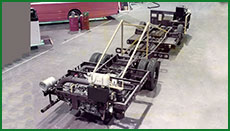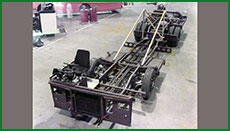Professional Review
PROFESSIONAL REVIEW of the significant part of my working life. This was written for The Institution of Mechanical Engineers
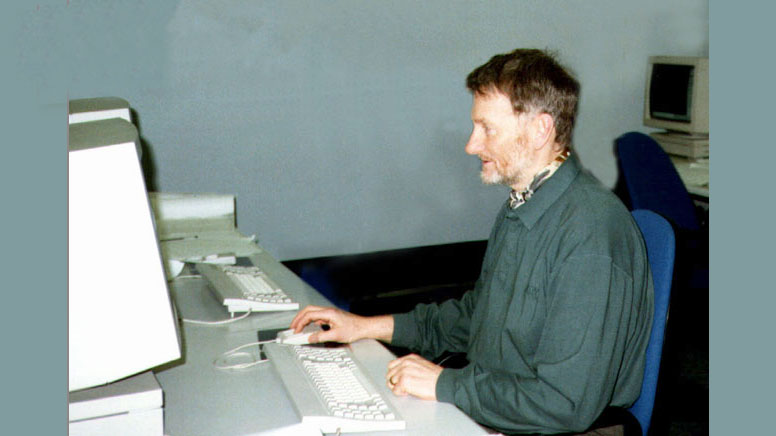
Working on the CAD computer, more or less where I ended up as the company, Leyland Product Developments, was nearing its demise.
All my experience has been in the Automotive Industry involved in the design of commercial vehicles. My early career was spent on transmission design initially working on the detail design of a range of heavy duty gearboxes and axles. In January 1966 I was promoted to Senior Designer going on to prepare original designs for two different new axles doing all the calculations, choosing the gear characteristics after research through papers, books and attending seminars etc..
In April 1969 I moved up into the Forward Projects Department as part of the team working on the new double deck bus (subject of IMechE paper 1978 Vol 192 No 7). I did the concept design of the new dropped centre rear axle, the design of the rear suspension and the independent front suspension structure.
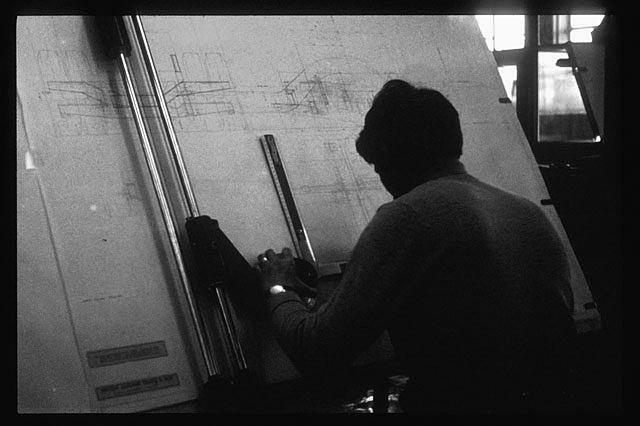
When we used to have to draw with pencils. This could have been the new double decker chassis?
In April 1974 I was promoted to Supervisor, Bus Structures, my first professional appointment, with three designers reporting to me. As a senior designer other designers had been assigned to me but this was the first time that I had had direct responsibility for the management and guidance of technical staff. I was responsible for all bus frames and mounts, including engine mountings and assisted in the introduction of computer and finite element analysis into chassis design.
In August 1977 I was promoted to Supervisor, Layouts and Structures, responsible for all bus layouts and structures with three senior engineers and twelve designers reporting to me. At this time I was becoming increasingly involved in human and industrial relations; interviewing, selection, training, development and promotion of staff and on one occasion organised the relocation of the department. In 1980 I was involved in the selection and purchase of Computervision Designer CAD equipment which we were to begin to exploit in my next position.
My next promotion was in December 1982 to Principal Engineer responsible for the design, test, development and introduction into production of our new worldwide city bus, the Lynx, subject of an IMechE paper (C205/86) by my colleague B S Hancock who was responsible for the body. I was responsible for the chassis (illustration 1) having about fifteen engineers / designers reporting to me plus the chassis engineering side of the new prototype department at Workington. We worked together with our teams reporting to our manager who reported to the Engineering Director. The manager took care of the interface between us and Sales and Marketing and customers at executive level, involving us when necessary and helping to present the new technologies we were proposing to the directors and at the same time making sure we kept to the project specification or negotiating any improvements we had designed or changes to targets that we could not realistically achieve. Creating the chassis frame was my major personal design contribution to the project and among my responsibilities in leading the design of the complete chassis were designing the space for all the units, services for the units (piping, wiring etc.), serviceability, accessability, correct environmental conditions for the units, weight, performance and manufacturability. At the start of the project we discussed with manufacturing the methods of manufacture that were available to us or that would be required. We visited likely suppliers, particularly the company that was to manufacture the frame components. I organised my staff to consult with the experts available to us within the company and outside eg legislation, ergonomics etc.. Some of our designers were either young engineers in their first appointment or designers inexperienced in chassis design. I allocated the work to suit their abilities and in such a way as they could develop as engineers and designers, using my knowledge of engineering and engineering principles. I planned the work so that the long lead time items were designed first and arranged for the ordering of all the material for prototype vehicles, spares and for use on the test rigs. Although we had a clean sheet of paper it was my responsibility to see that we made maximum use of existing components and not create any unnecessary new parts.
The Lynx frame is an all welded structure (illustration 2) a new departure for our company in this country. The frame was designed based on experience and knowledge gained on my earlier projects and making full use of the CAD equipment. The sections were initially chosen based on this experience and we did analysis work to prove them correct. Independent stress analysis by our colleagues showed that only minor adjustments to the design were necessary. I had to decide when the designs had reached the point where further work would yield little improvement on them, and for keeping within the target times for completion. At the time of prototype build I had to help the new prototype department to plan the stages of build, I was on the selection panel for the position of the engineer in charge at Workington.
| My finest hour at work. December 1983. The first prototype Leyland Lynx chassis outside the Prototype Department at Workington. | 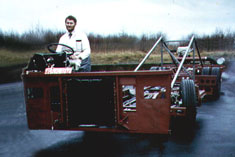 |
The first prototype arrived in Belfast on time. During this time I was involved with the sales and marketing of the bus and I spent some time with sales personnel, customers and the bodybuilders in Ulster and Perth Australia where the first two prototypes were respectively bodied. The Lynx is now established in the UK and is being considered for Europe. We have a demonstrator in Singapore creating interest in the Far East. We have had a few structural problems, sidemember crack and rear engine mounting crossmember failure, operating in Merthyr Tydfil but these have been satisfactorily resolved.
In September 1986 I was appointed to the position of Principal Engineer on Design Analysis, a new department developed out of the structures and materials department to bring together specialist knowledge and design experience to strengthen and broaden these into new fields and at the same time enabling fewer people to be employed in the area.
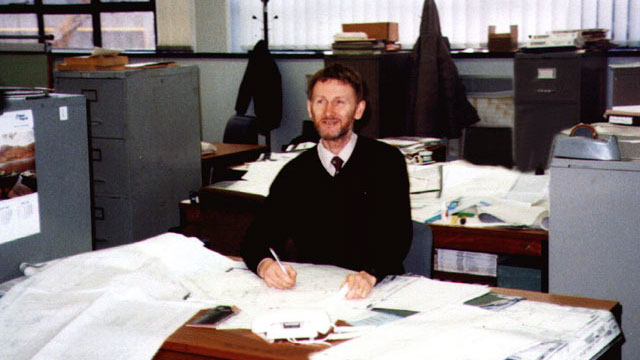
This was my desk when I worked on Design Analysis
The inspiration behind my appointment was that I would be able to use my knowledge and ability to filter engineering problems producing solutions relatively quickly and cheaply allowing us to concentrate our time on the difficult problems. I report direct to my chief engineer, who allocates my work and to whom I report work progress and completion, as one of the three principal engineers making up the department. There are about fifty engineers / designers who rely upon us for leadership and guidance on engineering problems, analysis, materials and in my case design. Our computer programs are supported by Istel and our own engineering services otherwise we are completely self reliant. My responsibilities include the leadership of the design of chassis frames and frame structures including in depth structural analysis, using the latest finite element techniques, and complete vehicle structural analysis. I apply scientific methods and outlook to the analysis and solution of engineering problems including original design and major service problems. I have to develop a thorough understanding of vehicle structures with special consideration to their influence on vehicle design. I am responsible for keeping abreast of new manufacturing methods and materials and to improve design and analysis methods through the creative use of new technology.
My first engineering problem in my new role was to fly out to Singapore to approve the fitment of a body, designed and manufactured in kit form in Scotland, onto the Olympian double deck chassis. In two weeks with the Singapore Bus Company's Engineers and a body Engineer from the Scottish bodybuilder I had to negotiate, as the Leyland Bus structural engineer, acceptable design compromises and convince the customer that the vehicle was structurally sound.
My next engineering problem was to analyse the design of a new heavy duty front axle beam. We have load conditions which have evolved over the years as have our methods of analysis and for a long time "belt and braces" designs have been created, but today we need to design to greater efficiency. I did my first serious structural analysis in the seventies on a rack and pinion steering gear using hand calculations. All my gear calculation previous to that time, although done by hand and involved, were following established procedures and the actual calculations did not require much intellectual effort. Since then from time to time I have been responsible for structural analysis but this was performed by the engineers and designers reporting to me. To bridge the gap I attended Nastran and Caeds courses at Istel so that I could combine my experience with the latest new technology and have continued to do so. The computer aided FE methods allow greater depth of investigation but they are not absolute. I took the existing beam and prepared a complex model (illustration 3). I used the knowledge of the use of the CV CAD design facility to prepare the geometry base of the model using the same data base that the designer had prepared transferring the model to the Istel Meteor system where we use Caeds and Nastran to do the analysis. This was another first for our company. Today my colleague has carried this further and we now prepare the finite element model on the CV system and write the Nastran file direct. I subjected it to all the known loads that are experienced in service. These loads are obtained by fitting transducers to existing vehicles. There was not time to do this so I had to research reports of previous tests. We had not the facilities to even subject the existing beam to simple deflection tests at the time so to proceed I had to make engineering judgements. Particular attention was paid to areas where the existing beam had failed. I prepared the new model (illustration 4) did the analysis comparing the results and proposed engineering changes or confirmed the design where it was acceptable to allow development of the design. We had to be right because we had to commit to production tooling to produce the prototype beams. I have colleagues to whom I can approach for information and discuss ideas with but at the end of the day it is my responsibility to provide design information. The axle, although not in series production yet, is successfully proceeding through the test programme.
In the spring of 1987 I was given my next engineering problem which was to design a chassis frame for a new concept of a minibus from a written specification and a thumbnail sketch. I produced a chassis frame design starting the iterative process of design - analysis - design etc., (illustration 5). The project was given to my Chief Engineer and we were assigned several inexperienced designers. I took over the design of the bus which fortunately coincided with an upgrade of our CAD designing facility which gave us the capability of user friendly 3D design. I organised the use of the system allocating layers to each designer's area of work and introduced them to 3D design. We kept a master scheme to control the project by renewing the layers when each designer made progress, my colleagues supplying us with expertise on suspensions, steering, brakes, power units and transmissions. The project almost collapsed because of transmission difficulties with drive angles making the costs unprofitable but over a weekend I was able to use the CAD technology to completely redesign the chassis layout and produced a totally new concept creating an acceptable proposal to put before the board (illustration 6). The board decided not to proceed with the project on economic grounds.
Recently I have been resolving two chassis structural problems (illustrations 7 & 8) and redesigning the floor of one of our buses to make it easier to manufacture. I am now working on the design of a new chassis frame.
The the type of work I did at this time was ranging from in depth structural analysis to the leadership of design in the resolving of mechanical engineering problems, to the training and development of engineers and designers.
I was soon to be required to take over the design of the new frame for the Volvo World Wide Low Floor City Bus, code named 5370. I wrote a paper on this project
